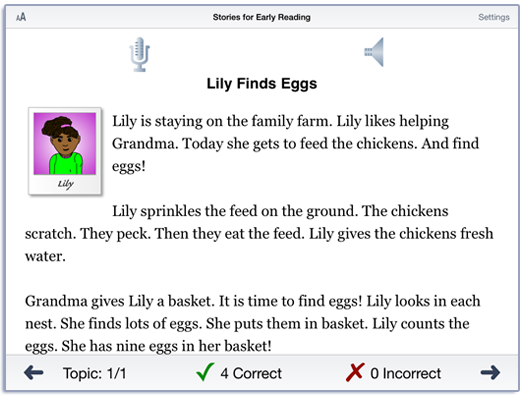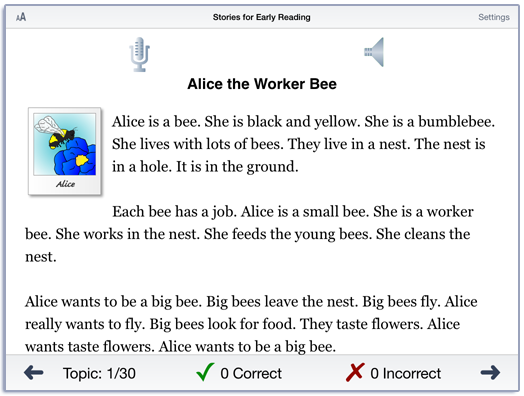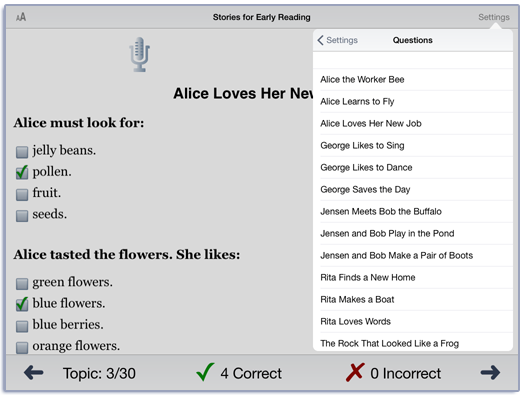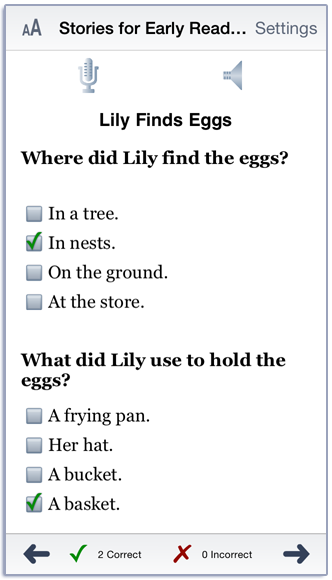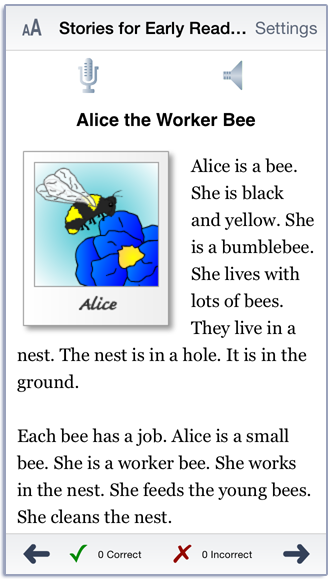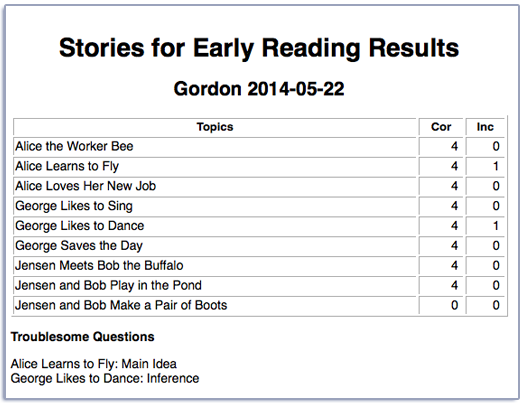Reading for Details: Stories for Early Reading Manual
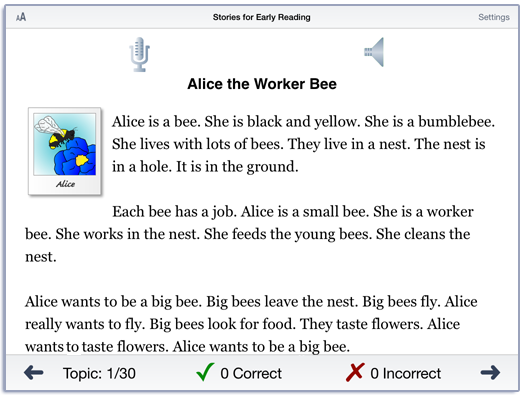
Contents
This app has 30 short stories. Most of the words are 1 or 2 syllables. They are in simple sentences. Most sentences have 5 to 8 words. The student is asked to answer three direct questions that rely on facts in the story. These stories are aimed at very early readers so the questions are straightforward. They do not require making inferences or judgements. In most cases, the correct answer can be found word-for-word in the story. The fourth question usually requires the student to recall multiple items from the story. At the end of each story there is an open ended question for discussion. This app is intended to be used by parents, Speech-Language Pathologists, and Special Education Teachers with children who are having difficulty with reading. It can also be used for remediation of attention and processing deficits due to attention deficit disorder, traumatic brain injury, or stroke.
Play
Tap the Play button (or the big button in the middle of the screen) to start. Read a paragraph, process the language concepts as a whole, while recalling specific details. Swipe to the next page, then demonstrate comprehension by responding to multiple choice questions. Swipe again and discuss the open-ended question. Sometimes the device interprets a swipe as a scroll. If you are having trouble swiping, use the arrow keys at the bottom of the screen to move around.
The app scores correct and incorrect answers and keeps track of the questions that were answered incorrectly. When a question is answered incorrectly a popup appears with a discussion of the answers. Often the student recognized words in the answer and chose them because they were familiar. After the student reads the explanation, they should answer the question again using the knowledge gained from the explanation.
You can make the text larger or smaller by tapping the resize button  at the top left of the screen.
at the top left of the screen.
How do you work on reading comprehension?
The process for reading comprehension work is the same as for auditory comprehension, except you will ask your students to read the sentences, either aloud or to themselves, before creating the visual images to match. Proceed slowly through the process of imaging each sentence. Taking time to understand each new word or concept is important. It is possible to spend fifteen minutes or more on a story. This is not inefficient. You are teaching a process that will become faster and more reliable. Speed is not the primary objective when first learning to have efficient comprehension. The sequence should be: understand individual words, understand the sentence, understand how the sentence relates to the one before it, understand how the sentence relates to something you already know, understand how the sentence relates to yourself or the world, make a judgment on the new information.
Settings
View the settings by tapping the Settings button at the top of the main game-play screen or at the bottom of the intro screen.
Pick a story from the Topics option. If you don’t pick a story then the app will start at the first story and continue sequentially.
You can download the stories and questions from our website.
The Options tab lets you sign in and the app will remember the name until you change it. If you enter a name, the results files will be stored with the name appended. e.g. Stories for Early Reading Results Child One 2015-05-27.html
You may show the explanation after every question is answered by tapping on the Always Show Explanation button.
When you change the name, a new file of results will be created. If you want to clear out the current results file, but not change the name, you can touch the Reset Scoring button.
The Results tab shows the results for the day. The app collects data on the total Correct and Incorrect answers. A new results file is created when you change the sign in name or when the day changes.
Viewing Results
You can print the results or use iTunes to copy the day’s results file to your computer for printing or archiving. The printed results include percentages as well as raw numbers for the responses. To view the results pages in iTunes, plug your iPad or iPod into your computer. Open iTunes. Under Devices you’ll see your device. Click on the device and look at the top of the screen. You will see a tab labeled Apps. Under that tab, there is a section for File Sharing. The name and icon for this app will be displayed. In the documents list next to it you will find all of the results pages that are stored on the device. Drag them to your desktop. They will open in your web browser where you can print them.
Objective
The client will attend and utilize auditory and/or visual memory to process, remember, and use information presented at the single word, phrase, sentence, and paragraph levels.
Rationale
Rationale: The paragraphs require multiple processing skills in attention, memory, and comprehension. Some individuals may need to address comprehension at the word or sentence level, but the eventual goal is comprehension at the paragraph level. It requires visual discrimination and reading comprehension. The developed higher level comprehension skills such as getting the main idea, inferring, predicting outcome, concluding consequences and evaluating the relevance of the material allow practice opportunities for improving reading comprehension and oral or written expressive language skills.
A Note About Grammar and Punctuation
The paragraphs in this app were written for children and adults who are having reading comprehension problems. The sentences are much shorter than in normal writing. Often just fragments. And we have no problem starting sentences with conjunctions. We use the Oxford comma extensively because it helps with understanding—especially with long sentences. And we use “they” as a gender neutral singular pronoun.
References
- Bell, N., (1991). Visualizing and Verbalizing for Language Comprehension and Thinking. San Luis Obispo, CA: Gander Publishing. (805-544-1819)
- Hegde, M. N., (1994). A Coursebook on Aphasia and other Neurogenic Language Disorders. San Diego, CA: Singular Publishing Group, Inc.
- Love, R. J., & Webb, W. G., (1996). Neurology for the Speech-Language Pathologist. Newton, MA: Butterworth- Heinemann.
- Wiig, E. H., & Semel, E., (1984). Language Assessment and Intervention for the Learning Disabled. Columbus, OH: Charles E. Merrill Publishing Company.
Credits
Stories by Nancy Scarry, MFA.
Screen Shots from iPhone and iPad
